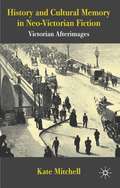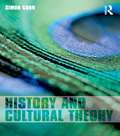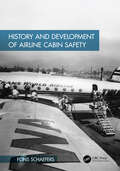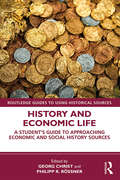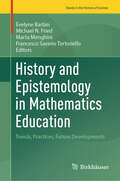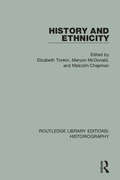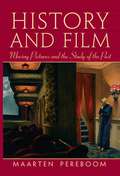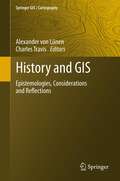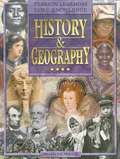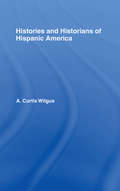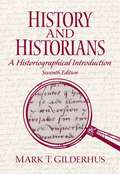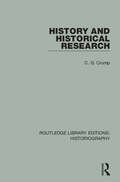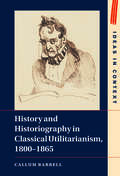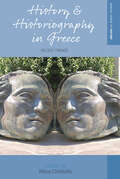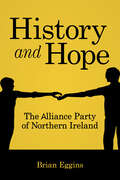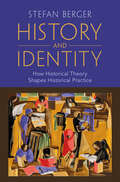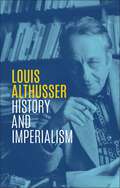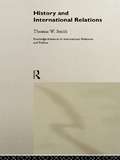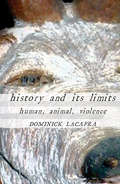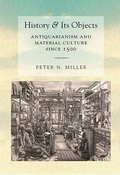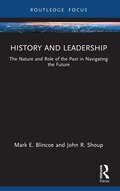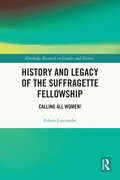- Table View
- List View
History and Cultural Memory in Neo-Victorian Fiction: Victorian Afterimages
by Kate MitchellArguing that neo-Victorian fiction enacts and celebrates cultural memory, this book uses memory discourse to position these novels as dynamic participants in the contemporary historical imaginary.
History and Cultural Theory
by Simon GunnIn recent times there has been recognition of the growing influence of cultural theory on historical writing. Foucault, Bourdieu, Butler and Spivak are just some of the thinkers whose ideas have been taken up and deployed by historians. What are these ideas and where do they come from? How have cultural theorists thought about 'history'? And how have historians applied theoretical insights to enhance their own understanding of events in the past? This book provides a wide-ranging and authoritative guide to the often vexed and controversial relationship between history and contemporary theory. It analyses the concepts that concern both theorists and historians, such as power, identity, modernity and postcolonialism, and offers a critical evaluation of them from an historical standpoint. Written in an accessible manner, History and Cultural Theory gives historians and students an invaluable summary of the impact of cultural theory on historiography over the last twenty years, and indicates the likely directions of the subject in the future.
History and Development of Airline Cabin Safety
by Fons SchaefersHistory and Development of Airline Cabin Safety offers an understanding of how cabin safety evolved over time. It covers six key areas: impact protection, fire protection, egress potential, life support equipment, information and instructions, and cabin professionals.Exploring the organic choreography of accidents, research, technological progress, rulemaking, and industry response, the book clarifies that cabin safety enhancements were not well planned but came incidentally and step by step. Each step was triggered by accidents with survivability issues, except in one area where a proactive approach proved to be first time right: oxygen for passengers. The step improvements, which mainly occurred in the U.S., concentrated in three waves centered around 1950, 1970, and 1985, respectively.The book will interest aviation regulators, aircraft manufacturers and operators, cabin safety professionals (including cabin crew), and accident investigation professionals.
History and Economic Life: A Student’s Guide to Approaching Economic and Social History Sources (Routledge Guides to Using Historical Sources)
by Philipp R. Rössner Georg ChristHistory and Economic Life offers students a wide-ranging introduction to both quantitative and qualitative approaches to interpreting economic history sources from the Middle Ages to the Twentieth Century. Having identified an ever-widening gap between the use of qualitative sources by cultural historians and quantitative sources by economic historians, the book aims to bridge the divide by making economic history sources more accessible to students and the wider public, and highlighting the need for a complementary rather than exclusive approach. Divided into two parts, the book begins by equipping students with a toolbox to approach economic history sources, considering the range of sources that might be of use and introducing different ways of approaching them. The second part consists of case studies that examine how economic historians use such sources, helping readers to gain a sense of context and understanding of how these sources can be used. The book thereby sheds light on important debates both within and beyond the field, and highlights the benefits gained when combining qualitative and quantitative approaches to source analysis. Introducing sources often avoided in culturally-minded history or statistically-minded economic history courses respectively, and advocating a combined quantitative and qualitative approach, it is an essential resource for students undertaking source analysis within the field.
History and Epistemology in Mathematics Education: Trends, Practices, Future Developments (Trends in the History of Science)
by Michael N. Fried Évelyne Barbin Marta Menghini Francesco Saverio TortorielloThis book explores the evolving relationship between the history and epistemology of mathematics and mathematics education over the past fifty years. Beginning with the international movement that emerged in the 1970s, it celebrates the enduring and expanding role of historical and epistemological perspectives in shaping teaching practices. Organized into seven thematic sections, the volume examines core issues such as how historical and epistemological insights enhance understanding of mathematical concepts, interdisciplinarity as a tool for teaching, and innovative approaches to teacher training. It also delves into the use of historical problems, ancient texts, and textbooks as teaching resources, alongside an analysis of the social and political dimensions of mathematics education. Special attention is given to the impact of the "modern mathematics" reform and its legacy in rekindling interest in the history of mathematics in education. Featuring contributions from diverse geographical and historical contexts, this book is an essential resource for teachers, researchers, and anyone passionate about the rich interplay of history, epistemology, and mathematics.
History and Ethnicity (Routledge Library Editions: Historiography)
by Maryon Mcdonald Elizabeth Tonkin Malcolm ChapmanThese essays examine the importance of historical consicousness and the role of historiography in ‘ethnic’ situations, exploring the many ways in which ethnic groups select history, write or rewrite it, rescue appropriate or ignore it, forget or traduce it. Drawing on expert knowledge of regions ranging from the Amazon to contemporary Germany, the contributors bring anthropological and historical understanding to answer these questions, and investigate major topics such as the relationship between ethnic, national and state identifications, and the cultural work of creating them. Examples include Afrikaaners and Northern Ireland Protestants, as well as Mormons and Catalans. Bringing together a variety of themes that have recently become the focus of study – ethnicity, the uses and nature of history and the likelihood of objectivity in historical telling – the book will be of great interest ot students in the social sciences, anthropology, politics, history and international relations.
History and Family Traditions in England and the Continent, 1000-1200 (Variorum Collected Studies)
by E.M.C. van HoutsThe Normans in France and England left a rich legacy in historiography and literature, which is the subject of this volume. Dr van Houts first deals with the Scandinavian inheritance, which together with contacts with Danish England and Byzantium led to an interesting mix of pagan and ecclesiastical themes. Next she analyses the propaganda that followed the Norman conquest of England, in which the panegyrics written by French clerks eager to gain favour contrast markedly with the almost unanimous condemnation of William’s actions on the Continent. Included is the earliest history of the battle of Hastings written in England, here published with a new English translation. The last papers consider the role of women in the transmission of knowledge about the past: in their families they passed on memories, and their importance as commissioners, readers and informants of chroniclers must also not be underestimated.
History and Film: Moving Pictures and the Study of the Past
by Maarten PereboomThe ability to view recorded moving pictures has had a major impact on human culture since the development of the necessary technologies over a century ago. For most of this time people have gone to the movies to be entertained and perhaps edified, but in the meantime television, the videocassette recorder (VCR), the digital versatile disk (DVD) player, the personal computer (desktop and laptop), the internet and other technologies have made watching moving pictures possible at home, in the classroom and just about anywhere else. Today, moving images are everywhere in our culture. Every day, moving picture cameras record millions of hours of activity, human and otherwise, all over the world: your cell phone makes a little video of your friends at a party; the surveillance camera at the bank keeps on eye on customers; journalists’ shoulder-carried cameras record the latest from the war zone; and across the world film artists work on all kinds of movies, from low-budget independent projects to the next big-budget Hollywood blockbuster. Moving pictures have had a great influence on human culture, and this book focuses on using moving images as historical evidence. Studying history means examining evidence from the past to understand, interpret and present what has happened in different times and places. We talk and write about what we have learned, hoping to establish credibility both for what we have determined to be the facts and for whatever meaning or significance we may attach to our reconstruction of the past. Studying history is a scientific process, involving a fairly set methodology. We tend to favor written sources, and we have tended to favor writing as a means of presenting our views of the past. But historians also use all kinds of other documents and artifacts in their work of interpreting the past, including moving pictures.
History and GIS: Epistemologies, Considerations and Reflections
by Alexander Von Lünen Charles TravisGeographical Information Systems (GIS) - either as "standard" GIS or custom made Historical GIS (HGIS) - have become quite popular in some historical sub-disciplines, such as Economic and Social History or Historical Geography. "Mainstream" history, however, seems to be rather unaffected by this trend. More generally speaking: Why is it that computer applications in general have failed to make much headway in history departments, despite the first steps being undertaken a good forty years ago? With the "spatial turn" in full swing in the humanities, and many historians dealing with spatial and geographical questions, one would think GIS would be welcomed with open arms. Yet there seems to be no general anticipation by historians of employing GIS as a research tool. As mentioned, HGIS are popular chiefly among Historical Geographers and Social and Economic Historians. The latter disciplines seem to be predestined to use such software through the widespread quantitative methodology these disciplines have employed traditionally. Other historical sub-disciplines, such as Ancient History, are also very open to this emerging technology since the scarcity of written sources in this field can be mitigated by inferences made from an HGIS that has archaeological data stored in it, for example. In most of Modern History, however, the use of GIS is rarely seen. The intellectual benefit that a GIS may bring about seems not be apparent to scholars from this sub-discipline (and others). This book wants to investigate and discuss this controversy. Why does the wider historian community not embrace GIS more readily? While one cannot deny that the methodologies linked with a GIS follow geographical paradigms rather than historical ones, the potential of GIS as a 'killer application' for digital historical scholarship should be obvious. This book brings together authors from Geography and History to discuss the value of GIS for historical research. The focus, however, will not be on the "how", but on the "why" of GIS in history.
History and Geography (Grade #5)
by E. D. Hirsch Jr.History and geography textbook for 5th graders.
History and Government of New Hampshire (A Student Workbook)
by Margaret K. MccormackAs you study about New Hampshire, you will learn some things about its history, government, its beautiful lakes and mountains, some people that have made contributions, and why N.H. still has people moving here to live.
History and Historians: A Historiographical Introduction (7th Edition)
by Mark T. GilderhusThis book presents a survey of Western historiography from ancient times to the present and shows how historians have grappled with the past in a search for meaning and how history as a body of knowledge has served different goals and purposes.
History and Historical Research (Routledge Library Editions: Historiography #11)
by C. G. CrumpAimed at students of history, this volume, originally published in 1928, examines the issues of impartiality and objectivity in the study of history. It also discusses the skills necessary for any would-be historian including the knowledge of foreign languages, the use of sources and note-taking.
History and Historiography in Classical Utilitarianism, 1800–1865 (Ideas in Context #136)
by Callum BarrellThis first comprehensive account of the utilitarians' historical thought intellectually resituates their conceptions of philosophy and politics, at a time when the past acquired new significances as both a means and object of study. Drawing on published and unpublished writings - and set against the intellectual backdrops of Scottish philosophical history, German and French historicism, romanticism, positivism, and the rise of social science and scientific history - Callum Barrell recovers the depth with which Jeremy Bentham, James Mill, George Grote, and John Stuart Mill thought about history as a site of philosophy and politics. He argues that the utilitarians, contrary to their reputations as ahistorical and even antihistorical thinkers, developed complex frameworks in which to learn from and negotiate the past, inviting us to rethink the foundations of their ideas, as well as their place in - and relationship to - nineteenth-century philosophy and political thought.
History and Historiography in Greece: Recent Trends (Making Sense of History)
by Nikos ChristofisAn updated guide to Greek historiography was long overdue. In this comprehensive and temporally wide-ranging reassessment, History and Historiography in Greece examines the evolution of Greek historical scholarship by reviewing the ideas, methods, and schools of history shaping the field. From how these developments correspond with international trends, to their rate of development alongside global shifts in scholarship, this volume identifies not only the ideological limitations shaping Greek academia, but also the innovations that are breaking new ground. In doing so, the contributors illuminate how those developments yield new lessons for existing conceptual frameworks within the fields of labor, gender, diaspora studies, and more.
History and Hope: The Alliance Party of Northern Ireland
by Brian EgginsIn 1970, a group of people had what many commentators felt was a ludicrous dream, that politics in Northern Ireland ‘should not be dominated by division, but should be about co-operation, partnership and reconciliation'. This dream was to become the Alliance Party of Northern Ireland. In the years since, this ambition to overcome tribal politics for a greater good has been preserved, through good times and bad. This book, the first full record of the development of the Alliance Party, charts that journey of hope and of history.
History and Identity
by Stefan BergerThis introduction to contemporary historical theory and practice shows how issues of identity have shaped how we write history. Stefan Berger charts how a new self-reflexivity about what is involved in the process of writing history entered the historical profession and the part that historians have played in debates about the past and its meaningfulness for the present. He introduces key trends in the theory of history such as postmodernism, poststructuralism, constructivism, narrativism and the linguistic turn and reveals, in turn, the ways in which they have transformed how historians have written history over the last four decades. The book ranges widely from more traditional forms of history writing, such as political, social, economic, labour and cultural history, to the emergence of more recent fields, including gender history, historical anthropology, the history of memory, visual history, the history of material culture, and comparative, transnational and global history.
History and Imperialism: Writings, 1963-1986
by Louis AlthusserWritings on History brings together a selection of texts by Louis Althusser dating from 1963 to 1986, including essays, a lecture, notes to his collaborators, and the transcript of an informal 1963 discussion of literary history. The centrepiece of this collection is Althusser’s previously unpublished Book on Imperialism, a theorization of globalized capitalism that remained unfinished. All these writings are concerned with the place of history in Marxist theory and, in particular, on what Althusser considered to be the mortal danger of historicism haunting the revolutionary reading of the present. They testify to his continuing dialogue with the historiography of his day, several of whose representatives were engaged in discussion and debate with him. Deeply interested in history but intent on avoiding the kind of interpretation that would transform it into a deterministic force, Althusser never ceased to reflect on the equilibrium between the historical and the concept in Marxist historiography, an equilibrium that he sought to reinvent for his time. The traces of that undertaking, which continues to generate debate throughout the world today, are brought together in this volume.
History and International Relations: History's Revenge And Future Shock (Routledge Advances in International Relations and Global Politics #97)
by Thomas W. SmithThis book is a major contribution to the debate about philosophy and method in history and international relations. The author analyses IR scholarship from classical realism to quantitative and postmodern work.
History and Its Limits: Human, Animal, Violence
by Dominick LacapraDominick LaCapra's History and Its Limits articulates the relations among intellectual history, cultural history, and critical theory, examining the recent rise of "Practice Theory" and probing the limitations of prevalent forms of humanism. LaCapra focuses on the problem of understanding extreme cases, specifically events and experiences involving violence and victimization. He asks how historians treat and are simultaneously implicated in the traumatic processes they attempt to represent. In addressing these questions, he also investigates violence's impact on various types of writing and establishes a distinctive role for critical theory in the face of an insufficiently discriminating aesthetic of the sublime (often unreflectively amalgamated with the uncanny). In History and Its Limits, LaCapra inquires into the related phenomenon of a turn to the "postsecular," even the messianic or the miraculous, in recent theoretical discussions of extreme events by such prominent figures as Giorgio Agamben, Eric L. Santner, and Slavoj Zizek. In a related vein, he discusses Martin Heidegger's evocative, if not enchanting, understanding of "The Origin of the Work of Art." LaCapra subjects to critical scrutiny the sometimes internally divided way in which violence has been valorized in sacrificial, regenerative, or redemptive terms by a series of important modern intellectuals on both the far right and the far left, including Georges Sorel, the early Walter Benjamin, Georges Bataille, Frantz Fanon, and Ernst Jünger. Violence and victimization are prominent in the relation between the human and the animal. LaCapra questions prevalent anthropocentrism (evident even in theorists of the "posthuman") and the long-standing quest for a decisive criterion separating or dividing the human from the animal. LaCapra regards this attempt to fix the difference as misguided and potentially dangerous because it renders insufficiently problematic the manner in which humans treat other animals and interact with the environment. In raising the issue of desirable transformations in modernity, History and Its Limits examines the legitimacy of normative limits necessary for life in common and explores the disconcerting role of transgressive initiatives beyond limits (including limits blocking the recognition that humans are themselves animals).
History and Its Objects: Antiquarianism and Material Culture since 1500
by Peter N. MillerCultural history is increasingly informed by the history of material culture—the ways in which individuals or entire societies create and relate to objects both mundane and extraordinary—rather than on textual evidence alone. Books such as The Hare with Amber Eyes and A History of the World in 100 Objects indicate the growing popularity of this way of understanding the past. In History and Its Objects, Peter N. Miller uncovers the forgotten origins of our fascination with exploring the past through its artifacts by highlighting the role of antiquarianism—a pursuit ignored and derided by modem academic history—in grasping the significance of material culture.From the efforts of Renaissance antiquarians, who reconstructed life in the ancient world from coins, inscriptions, seals, and other detritus, to amateur historians in the nineteenth century working within burgeoning national traditions, Miller connects collecting—whether by individuals or institutions—to the professionalization of the historical profession, one which came to regard its progenitors with skepticism and disdain. The struggle to articulate the value of objects as historical evidence, then, lies at the heart both of academic history-writing and of the popular engagement with things. Ultimately, this book demonstrates that our current preoccupation with objects is far from novel and reflects a human need to reexperience the past as a physical presence.
History and Leadership: The Nature and Role of the Past in Navigating the Future (Leadership Horizons)
by John R. Shoup Mark E. BlincoeLeaders and managers are rightly tasked to take their organizations and communities to a desired future. They are expected to be forward looking with compelling vision statements. As a result, they are often too busy in the present managing the future to be bothered with the past. Yet it is organizational histories that provide the contexts and clues for the future. History and Leadership: The Nature and Role of the Past in Navigating the Future demonstrates that intentional historical perspective-taking provides a sort-of wisdom for doing business in the present and future and equips leaders to leverage the past to help their organizations thrive. This book appeals to several audiences. It will serve as a supplementary text for undergraduate and graduate students in both the humanities and leadership studies. The book also appeals to practicing leaders and managers who wish to develop their emotional, cultural, and social intelligence by exploring perennial issues and lessons found in well-developed histories. This book also serves as a stand-alone read for a range of professionals who want a more recreational and non-traditional read on history and leadership. The book cultivates an appreciation for history and equips readers to be connoisseurs of history for the betterment of themselves and society.
History and Legacy of the Suffragette Fellowship: Calling all Women! (Routledge Research in Gender and History)
by Eileen LuscombeHistory and Legacy of the Suffragette Fellowship provides a biographical account of the scope and depth of the memory work of the now-forgotten commemorative group the Suffragette Fellowship, active from the 1920s to the 1970s. The Suffragette Fellowship comprised members from the militant suffrage groups known as the Women’s Social and Political Union, the Women’s Freedom League, and the Actress Franchise League. This research provides a comprehensive analysis of the Fellowship’s attempts to form and sustain a collective Suffragette identity across four decades of activity. It considers the legacy of contested histories attached to militant campaigning that pressured Fellowship leaders to take control of the public memory of suffrage history. With close attention given to a neglected piece of feminist history, this book highlights the cultural and political impacts that the Fellowship enacted in their memory of the women’s suffrage movement. Richly illustrated with images of members, artefacts, and publications, this extensive study of the Suffragette Fellowship adds to transnational suffrage histories in the United Kingdom and Australia and will be of interest to scholars in memory studies and women’s history.
